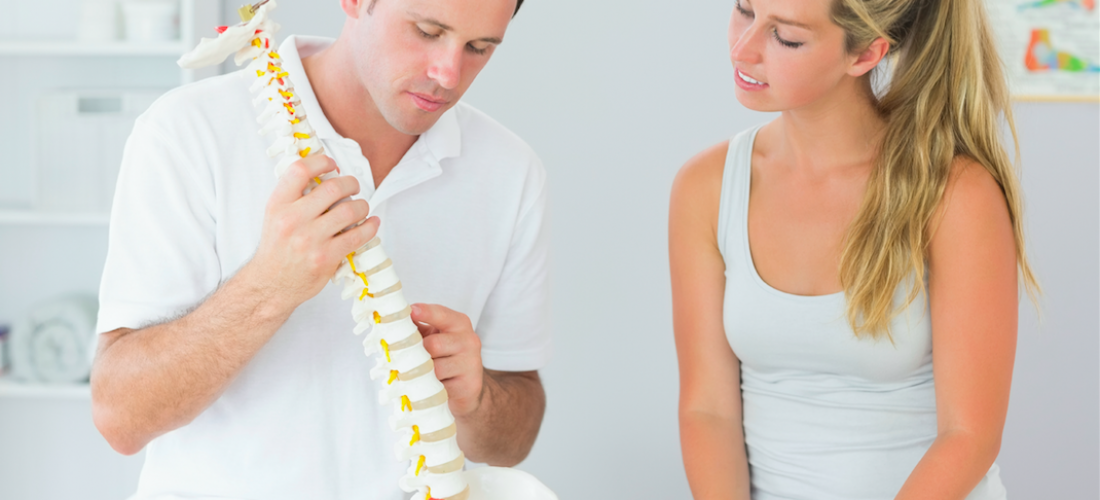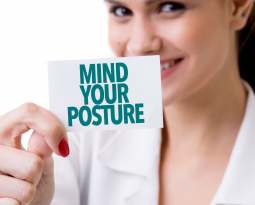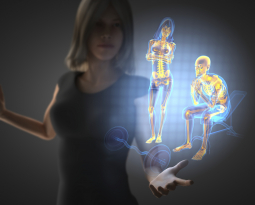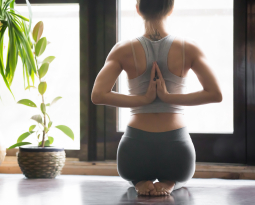
International Posture Expert Reveals Everything You Need to Know About Posture
In honor of National Correct Posture Month, Dr. Krista Burns, an international Certified Posture Expert reveals everything you need to know about posture and how it impacts your health.
Poor posture is not a problem in our society; it is an epidemic. 90% of the population presents with postural distortion patterns contributing to the fact that 80% of Americans present with back pain at some point in their lives.
As technology advances, posture weakens. Not only are adults feeling the pressure of poor posture, 65% of our children now present with low back pain.
We will discuss what posture is, how it impacts your health, and the consequences of poor postural design. Proper posture is a lifestyle choice greatly impacting your ability to thrive in your environment. Upright postural presentation is associated with health and longevity, whereas poor posture contributes to pain and dysfunction.
What is “Posture?”
Posture is the position in which you hold your body upright against gravity while standing, sitting or lying down. With proper posture there is an efficient utilization of energy to hold the body upright against the ever present force of gravity.
Good posture involves training your body to stand, walk, sit and lie in positions where the least strain is placed on supporting muscles and ligaments during movement or weight-bearing activities.
Maintaining good posture involves training your body to move and function where the least strain is placed on the body. Good posture improves the physiologic function of your body, while improving your appearance and saving your energy.
Why is Posture Important to Health?
Proper posture is a key component to optimal health and wellness. Posture is not just about how you look on the outside, it is about how you function on the inside. Proper posture helps you look better, move better, and feel better.
When the body is in proper alignment it can function more efficiently by decreasing the stress on the ligaments of the spine and keeping the bones and joints in the correct alignment. Proper alignment allows muscles to work without excessive muscle strain. Normal pull of the muscles helps decrease the abnormal wearing of joint surfaces that could result in arthritis.
With an aligned postural design of the human body, organic function is improved. Many people don’t realize that it is harder to breath while slouching. Proper posture with the chest elevated does not depress the diaphragm. A free moving diaphragm helps to optimize breathing patterns, oxygen consumption, and circulation.
What are the Consequences of Poor Posture?
When the body is in a slouched forward position with the head and shoulders rolled forward, our rib cage is actually pushing down on our internal organs. This commonly causes problems with respiration, circulation, and digestion. Forward head posture, when the head goes forward in relation to the shoulders, may also cause health discrepancies such as headaches, migraines, and fatigue.
Common short-term effects of bad posture are muscular soreness, neck pain, back pain, and headaches. If postural imbalances go uncorrected, further consequences may occur throughout the body, such as: spinal degeneration, arthritic joints, organic dysfunction and decreased balance.
Remember our posture is always with us, including when we are moving and walking. Poor static posture leads to problematic dynamic posture, or posture with movement. Postural distortion patterns during repetitive daily activities, such as walking, can cause pain and fatigue with movement.
How Do I Know if I Have Proper Posture?
Check your posture reflection in the mirror. Perform a posture self check in the mirror each morning. What does your reflection show? Good, strong, confident posture? Or slouched forward and closed posture? Be sure to fix your posture before leaving the house- just as you would fix your hair if it were out of place.
When you look in the mirror your shoulders should be at the same height bilaterally over your hips, and your head and feet pointing straight ahead. Your ears should be in alignment over your shoulders. If your ears are further forward than your shoulders, then you to pull your chin back. Likewise with your shoulders, if they anteriorly towards your chest, pull your shoulders back with your chest elevated.
How Can I Help my Child Stop Slouching?
Posture is very important for children too! In fact, each child should have a yearly posture evaluation starting at age 6 years old and carrying on throughout the child’s development to adulthood. Posture evaluations with Posture Imaging demonstrate early onset of postural distortion patterns so they can be corrected by a Certified Posture Expert immediately.
Children begin developing their habits when they start school. You can help them stop slouching by showing them how to sit properly with their head pulled back over their shoulders and their shoulders pulled back over their hips. Both feet are on the ground, and the spine has a normal “S” curve, not a “C” shaped curve with the shoulders forward.
Teach them how to sit properly at school and make sure their backpacks aren’t too heavy. Children should not carry backpacks that exceed 10% of their body weight. When wearing the backpack, it should be centered over both shoulders, not hanging on one side and the heaviest items should be closer to the spine for better support.
What are the Best Exercises to do for Posture?
At the American Posture Institute we recommend the Postural ABCs. The “A” stands for “Alignment,” “B” represents “Balance,” and “C” is “Core Control.”
Alignment: Alignment exercises help keep the spine in proper orientation. Patients should perform Neck Retractions to keep the neck in proper alignment over the shoulders and API Wall Posture to keep the lower back and hips in proper alignment.
To perform Neck Retractions, stand with your back against the wall and pull the chin back while keeping the eyes parallel with the horizon and looking forward. As the head is drawn back, push your head back against the wall feeling the muscles of the neck contracting. Perform two sets of 10 repetitions.
API Wall Posture is performed against the wall with your head, shoulders, and hips against the wall. The arms and palms of the hands are facing out, but placed against the walls. The legs are straight and the feet are one step forward from the wall. With the hips, shoulders, and arms against the wall perform pelvic tucks and arches with the hips. An arch is when there is space between the lumbar spine and the wall. When you tuck the pelvis, the lumbar spine is completely against the wall. Be sure to keep the legs straight, and you should feel contraction of the core musculature. Perform 2 sets of 5 repetitions.
Balance: Balance exercises are to improve postural balance. The best exercise to do is One-Leg Balance in which you balance on one leg with proper posture. To perform the exercise, stand with feet together and pull one leg up so that the hip is angled at 90 degrees. The thigh is parallel to the ground and there is a 90-degree angle at the knee with the knee and ankle in alignment. The foot in the air and the foot planted on the ground are both pointing forward. Keep your back straight, shoulders back, ears aligned over your shoulders, and hips in even alignment with another. The goal is to hold this exercise for 30 seconds per leg with proper posture and minimal sway.
Core Control: Core Control exercises strengthen the core musculature, specifically the deep transversus abdominis muscle, to support the low back and prevent lumbar spinal injuries. The best Core Control exercise is the plank. To perform a plank, you will begin by stacking your shoulder over your elbow with your forearms on the floor and the palms down. Push the feet into the ground. You will hold your body up with just the forearms and the feet touching the ground.
The neck is in a neutral position, the spine is straight, the hips are in a neutral position with a strong abdominal contraction, the scapulae are not sticking out, and the legs are straight. The goal is to hold this position for 1 minute with proper form. If this is too difficult, start by doing planks for 15 seconds, then 30 seconds, then 45 seconds, then increase to one minute. Perform the plank three times.
What are some other Posture Tips?
- Don’t bend at the waist to pick up an item and avoid twisting the spine. Squat down with your back straight and core muscles contracted.
- Sleep on your back or your side, not on your stomach and find a pillow that allows you to keep a neutral position of the cervical spine during the night.
- Don’t look down at your phone, pull your phone up to eye level when texting. Looking down causes excessive strain to the neck.
- When typing on a computer make sure that the computer monitor is at eye level to avoid looking down and straining the neck for prolonged periods of time.
- Put your wallet in your front pocket. If you sit on your wallet in your back pocket, it causes a postural imbalance of the hips.
- Take “Posture Breaks” at work. While seated, open your chest, drop your head back and extend your arms back with your palms up. Keep your back straight and feel a nice stretch through the tight musculature of the anterior chest cavity.
- If you carry a purse, avoid carrying a purse over the same shoulder each day. Be sure to switch shoulders and avoid carrying loads that exceed 10 percent of your body weight.
- Have a yearly posture evaluation with posture imaging done to detect early onset of postural distortion patterns.
Remember, it’s Posture By Design, Not By Circumstance. To schedule your annual posture evaluation, consult a Certified Posture Expert in your community. To locate a Certified Posture Expert visit www.AmericanPostureInstitute.com.
Dr. Krista Burns is a Certified Posture Expert, Doctor of Chiropractic and a Doctor of Health Administration. She is the co-founder of the American Posture Institute and is dedicated to being the world’s leading professional resource for posture-related information, products, and correction systems.
Dr. Krista is the author of the evidence-based textbook, The Principles of Posturology, and has created and implemented a publicly recognized postural hygiene program called “Better Posture for Brighter Futures” which has been implemented throughout the Italian school system.
She is the co-founder of the Certified Posture Expert Program, an intensive online certification educating healthcare professionals of the theories of Posturology, how to perform postural evaluations with clinical precision, and complete postural correction strategies.

















